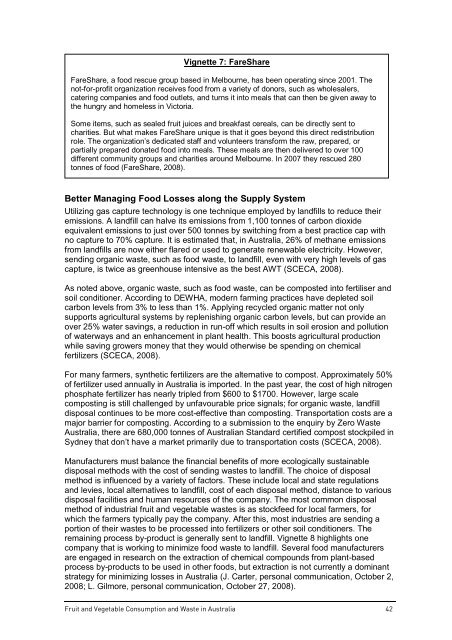Fruit and vegetable consumption and waste in Australia - VicHealth
Fruit and vegetable consumption and waste in Australia - VicHealth
Fruit and vegetable consumption and waste in Australia - VicHealth
Create successful ePaper yourself
Turn your PDF publications into a flip-book with our unique Google optimized e-Paper software.
Vignette 7: FareShare<br />
FareShare, a food rescue group based <strong>in</strong> Melbourne, has been operat<strong>in</strong>g s<strong>in</strong>ce 2001. The<br />
not-for-profit organization receives food from a variety of donors, such as wholesalers,<br />
cater<strong>in</strong>g companies <strong>and</strong> food outlets, <strong>and</strong> turns it <strong>in</strong>to meals that can then be given away to<br />
the hungry <strong>and</strong> homeless <strong>in</strong> Victoria.<br />
Some items, such as sealed fruit juices <strong>and</strong> breakfast cereals, can be directly sent to<br />
charities. But what makes FareShare unique is that it goes beyond this direct redistribution<br />
role. The organization’s dedicated staff <strong>and</strong> volunteers transform the raw, prepared, or<br />
partially prepared donated food <strong>in</strong>to meals. These meals are then delivered to over 100<br />
different community groups <strong>and</strong> charities around Melbourne. In 2007 they rescued 280<br />
tonnes of food (FareShare, 2008).<br />
Better Manag<strong>in</strong>g Food Losses along the Supply System<br />
Utiliz<strong>in</strong>g gas capture technology is one technique employed by l<strong>and</strong>fills to reduce their<br />
emissions. A l<strong>and</strong>fill can halve its emissions from 1,100 tonnes of carbon dioxide<br />
equivalent emissions to just over 500 tonnes by switch<strong>in</strong>g from a best practice cap with<br />
no capture to 70% capture. It is estimated that, <strong>in</strong> <strong>Australia</strong>, 26% of methane emissions<br />
from l<strong>and</strong>fills are now either flared or used to generate renewable electricity. However,<br />
send<strong>in</strong>g organic <strong>waste</strong>, such as food <strong>waste</strong>, to l<strong>and</strong>fill, even with very high levels of gas<br />
capture, is twice as greenhouse <strong>in</strong>tensive as the best AWT (SCECA, 2008).<br />
As noted above, organic <strong>waste</strong>, such as food <strong>waste</strong>, can be composted <strong>in</strong>to fertiliser <strong>and</strong><br />
soil conditioner. Accord<strong>in</strong>g to DEWHA, modern farm<strong>in</strong>g practices have depleted soil<br />
carbon levels from 3% to less than 1%. Apply<strong>in</strong>g recycled organic matter not only<br />
supports agricultural systems by replenish<strong>in</strong>g organic carbon levels, but can provide an<br />
over 25% water sav<strong>in</strong>gs, a reduction <strong>in</strong> run-off which results <strong>in</strong> soil erosion <strong>and</strong> pollution<br />
of waterways <strong>and</strong> an enhancement <strong>in</strong> plant health. This boosts agricultural production<br />
while sav<strong>in</strong>g growers money that they would otherwise be spend<strong>in</strong>g on chemical<br />
fertilizers (SCECA, 2008).<br />
For many farmers, synthetic fertilizers are the alternative to compost. Approximately 50%<br />
of fertilizer used annually <strong>in</strong> <strong>Australia</strong> is imported. In the past year, the cost of high nitrogen<br />
phosphate fertilizer has nearly tripled from $600 to $1700. However, large scale<br />
compost<strong>in</strong>g is still challenged by unfavourable price signals; for organic <strong>waste</strong>, l<strong>and</strong>fill<br />
disposal cont<strong>in</strong>ues to be more cost-effective than compost<strong>in</strong>g. Transportation costs are a<br />
major barrier for compost<strong>in</strong>g. Accord<strong>in</strong>g to a submission to the enquiry by Zero Waste<br />
<strong>Australia</strong>, there are 680,000 tonnes of <strong>Australia</strong>n St<strong>and</strong>ard certified compost stockpiled <strong>in</strong><br />
Sydney that don’t have a market primarily due to transportation costs (SCECA, 2008).<br />
Manufacturers must balance the f<strong>in</strong>ancial benefits of more ecologically susta<strong>in</strong>able<br />
disposal methods with the cost of send<strong>in</strong>g <strong>waste</strong>s to l<strong>and</strong>fill. The choice of disposal<br />
method is <strong>in</strong>fluenced by a variety of factors. These <strong>in</strong>clude local <strong>and</strong> state regulations<br />
<strong>and</strong> levies, local alternatives to l<strong>and</strong>fill, cost of each disposal method, distance to various<br />
disposal facilities <strong>and</strong> human resources of the company. The most common disposal<br />
method of <strong>in</strong>dustrial fruit <strong>and</strong> <strong>vegetable</strong> <strong>waste</strong>s is as stockfeed for local farmers, for<br />
which the farmers typically pay the company. After this, most <strong>in</strong>dustries are send<strong>in</strong>g a<br />
portion of their <strong>waste</strong>s to be processed <strong>in</strong>to fertilizers or other soil conditioners. The<br />
rema<strong>in</strong><strong>in</strong>g process by-product is generally sent to l<strong>and</strong>fill. Vignette 8 highlights one<br />
company that is work<strong>in</strong>g to m<strong>in</strong>imize food <strong>waste</strong> to l<strong>and</strong>fill. Several food manufacturers<br />
are engaged <strong>in</strong> research on the extraction of chemical compounds from plant-based<br />
process by-products to be used <strong>in</strong> other foods, but extraction is not currently a dom<strong>in</strong>ant<br />
strategy for m<strong>in</strong>imiz<strong>in</strong>g losses <strong>in</strong> <strong>Australia</strong> (J. Carter, personal communication, October 2,<br />
2008; L. Gilmore, personal communication, October 27, 2008).<br />
<strong>Fruit</strong> <strong>and</strong> Vegetable Consumption <strong>and</strong> Waste <strong>in</strong> <strong>Australia</strong> 42


